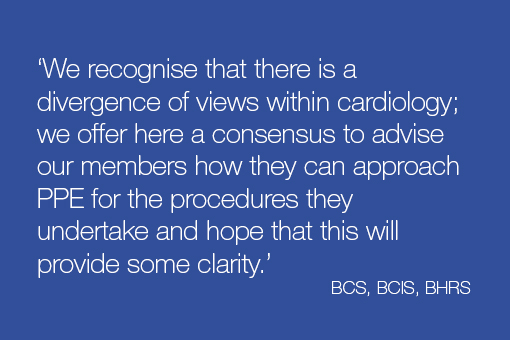BCS, BCIS & BHRS Response to PHE Updated Guidance on PPE

Public Health England (PHE) has now produced updated guidance on recommended PPE, endorsed by the four Chief Medical Officers. BCS, BCIS and BHRS would like to offer some guidance that interprets these principles in the context of cardiology-specific scenarios.
This guidance adopts an approach in which the PPE strategy is dependent upon both (a) the location in which patient contact occurs and (b) the likelihood that the contact will involve an aerosol generating procedure (AGP).
For cardiology, this applies to any procedure requiring or likely to require resuscitation for cardiac arrest involving CPR ± intubation and to transoesophageal echocardiography.
These procedures require disposable gloves, fluid resistant gowns, a filtering face piece respirator and eye/face protection wherever they are performed (termed type 2 PPE). Other procedures require disposable gloves, plastic apron (when not scrubbed), fluid resistant surgical mask and eye protection (termed type 1 PPE).
Ward environments are covered within the PHE guidance.
For catheter lab procedures the PHE guidance can be applied to the individual case by the assessment of the senior clinician, together with senior cath lab staff, taking into account (a) the likelihood that the patient has the virus and (b) the chance the procedure will be AGP. Our recommendations for the catheter lab are:
For primary PCI and other situations where the patient is admitted directly to the lab or via a resuscitation area in a haemodynamically unstable state the default is that the first operator, assistant and others with direct patient contact (within 1 metre) should wear type 2 PPE.
Note 1. It may well be the case that in many catheter labs, every member of staff will be within 1 metre of the patient at some point during the case.
Note 2. If some members of staff are not wearing type 2 PPE and there is a cardiac arrest, those staff should leave the lab immediately and only return if wearing full PPE.
For patients admitted to the lab already intubated or where there is felt to be a very high risk of arrest with prolonged resuscitation then all those within the lab to wear type 2 PPE.
For other situations the cath lab, when deemed low risk of AGP, can be regarded as an inpatient area or operating theatre with suspected or confirmed COVID cases and type 1 PPE is recommended for all those with direct patient contact (within 1 metre).
We recognise that there is a divergence of views within cardiology; we offer here a consensus to advise our members how they can approach PPE for the procedures they undertake and hope that this will provide some clarity.
.
Prof Simon Ray
President
British Cardiovascular Society (BCS)
Prof Nick Curzen
President
British Cardiovascular Intervention Society (BCIS)
Dr Alistair Slade
President (Elect)
British Heart Rhythm Society (BHRS)


Useful Links
Public Health England Poster: PPE in a Clinical Context
Recommended PPE for healthcare workers by secondary care inpatient clinical setting, NHS and independent sector.
View/Download the poster.
Public Health England Poster: COVID-19 Safe Ways of Working
This poster provides a visual guide to safe PPE. View/Download poster.
